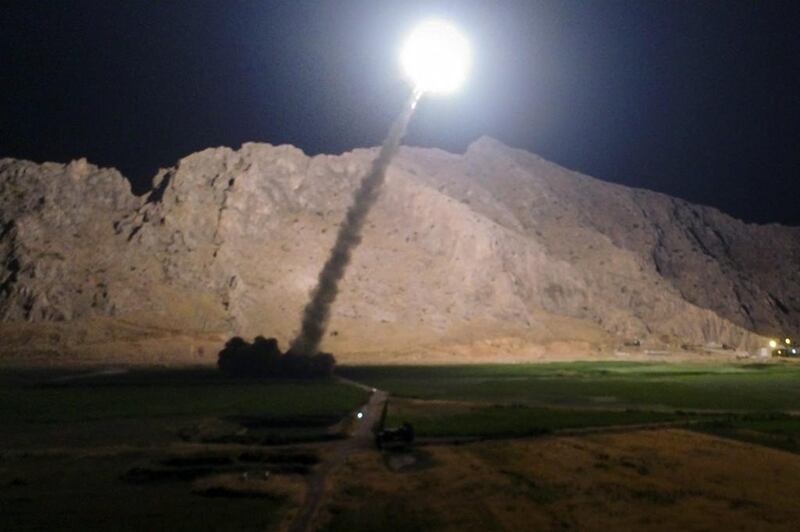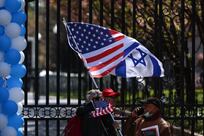Last week, Iran announced it had launched six missiles – including its Zulfiqar mid-range ballistic missile – at the Syrian city of Deir Ezzor, an ISIL stronghold.
According to the Islamic Revolution Guards Corps, which controls Iran’s missile development and use, the strike destroyed targets including ISIL's regional headquarters, as well as several ammunition dumps and a logistics centre.
The operation was probably co-ordinated with the Syrian government, an Iranian ally. However, Iran’s objective was not to provide support to government troops trying to consolidate control over the city or to dislodge the terrorist organisation. Its intent was, in truth, much greater.
Iran’s missile strikes were retaliation for ISIL carrying out its first successful attack in Iran on June 7, which killed 18, wounded 53 and traumatised the country. The attack symbolically targeted two prominent Iranian sites: the Imam Khomeini mausoleum, the final resting place of the Islamic revolution’s founder and the parliament, the symbol of Iran’s imperfect democracy.
Perhaps more importantly, the strike sent a message to both Iranians and the international community. Its code name, Laylat Al Qadr, after one of the holiest nights of the year in the Islamic calendar, clearly shows its symbolic weight.
In attacking Deir Ezzor, the IRGC also reaffirmed Syria’s strategic role to Iran despite its significant human and financial cost. While Iranians increasingly criticise hardliners and the IRGC, seeking attention instead on the country’s economic difficulties. It is also a way for the IRGC to show Iranians the organisation will protect the country at all costs.
But beyond this, the strike was also an attempt at distracting Iranians from the disturbing reality that ISIL recruited the terrorists from among Iranian Kurds, while security forces, including the IRGC and the ministry of intelligence and security, are conducting operations throughout the country. In this regard, while it was most probably related to technical necessity, launching missiles from Iranian Kurdish provinces will be perceived as a sign of nationalism and unity beyond religion and ethnicity.
The actual impact of the missile strikes and the number of deaths are yet to be independently assessed. However, Iranian sources claimed the missiles killed the local ISIL deputy chief, an individual Iran identified as a Saudi national named Saad Al Husseini.
The reported nationality of the only named casualty is significant, as it allows Iran to position itself as the victim of a regional plot to destabilise the country. Immediately following the ISIL attack, the IRGC claimed Saudi Arabia has played a role by financially supporting the radicalisation of Sunni Iranian Kurds. For the past few years, Tehran, without questioning its responsibilities, has observed with concern growing signs of Sunni radicalisation within Iranian Kurdish provinces, which were previously marked by Marxism, feminism and agnosticism.
But Iran’s strike also sent a message to the United States, whose senate recently passed a bill to impose unilateral sanctions on individuals involved in Iran’s ballistic missile programme. The missile strike placed the Trump administration in a situation where, despite opposing Iran’s ballistic missile development, it cannot deny the strike was a proportionate response to a deadly terrorist attack.
It is also a message to Saudi Arabia, whose leaders probably viewed the use of the Zulfiqar missile as a direct threat. Due to the level of tension between the two countries, Saudi Arabia probably felt singled out by IRGC Brig Gen Ahmad Reza Pourdastan’s comments that the strike was a “crushing response and a warning to those seeking to ignite tensions with their troublemaking and ignorant ambitions”.
Iran’s missile attack is a sobering moment for the region, as it suggests the accuracy of Iran’s ballistic missiles have been underestimated.
Iran continuously reminds the international community its ballistic missile programme stems from the country’s past inability to defend itself from Saddam Hussein’s aggression during the Iran-Iraq war. While Iranian foreign minister Mohammad Javad Zarif reiterated that the country’s missile power is aimed at safeguarding its citizens in “lawful self-defence”, he added for the first time a comment that Iran would also advance the “common global fight to eradicate IS [ISIL] and extremist terror”.
Mr Zarif’s comment implies the ISIL attack against Iran legitimises future missile strikes on its position. Such strikes could become more common as part of a new military strategy to limit the human cost and social impact of the country’s involvement in Syria. More significantly, it offers Iranian scientists a way to test and further improve the country’s ballistic missiles, complete with the risk of a regional arms race and the conflicts it may involve.
Marc Martinez is a senior analyst at The Delma Institute in Abu Dhabi
On Twitter @marcFmartinez





